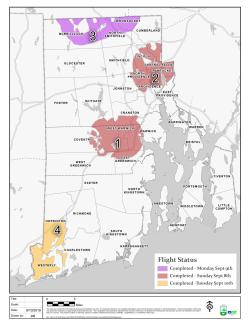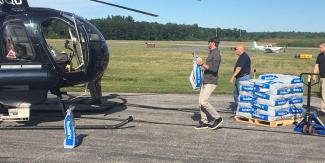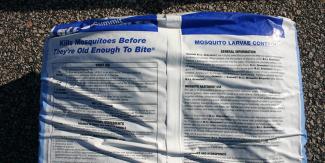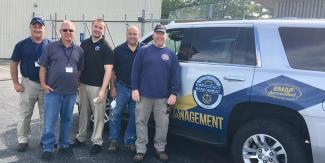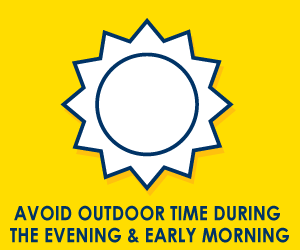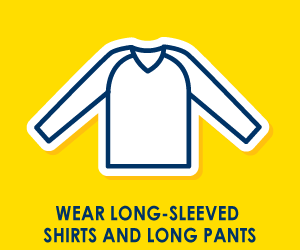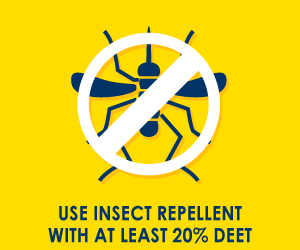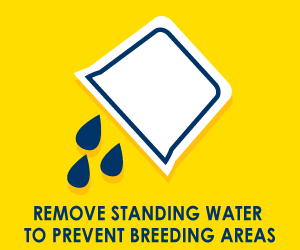Mosquito Control
2025 Season Mosquito Monitoring
Mosquito trapping and testing have concluded for the 2025 mosquito season. Due to seasonally low mosquito populations, the risk of mosquito-borne disease has significantly decreased. However, until the entire state experiences a true hard frost (defined as three consecutive hours below 32 degrees), which kills adult mosquitoes, a low risk of mosquito-borne disease remains.
Check the Rhode Island Department of Health (RIDOH)’s arboviral surveillance data webpage for the mosquito trapping and testing totals for the 2025 season.

- RIDOH Announces Second Human Case of West Nile Virus in 2025 Published Tuesday, November 4, 2025
- RIDOH Announces First Probable Human Case of West Nile Virus (WNV) in 2025, Published on Thursday, September 25, 2025
- RI Mosquito Report - West Nile Virus Detected in Providence Published on Thursday, September 18, 2025
- RI Mosquito Report - West Nile Virus Again Detected in East Providence Published on Thursday, September 11, 2025
- RI Mosquito Report - West Nile Virus Detected in East Providence Published on Thursday, September 04, 2025
- West Nile Virus Detected in Johnston, East Providence, and Cranston Published on Thursday, August 28, 2025
- West Nile Virus Detected in East Providence, Westerly, and West Greenwich Published on Thursday, August 21, 2025
- West Nile Virus Detected in Mosquito Sample Found in Bristol Published on Thursday, August 07, 2025
- First West Nile Virus Detection of 2025 Published on Thursday, July 31, 2025
- Fight the Bite this Summer - First RI Mosquito Report of 2025 Published on Thursday, June 12, 2025
- Town of Westerly to Conduct Aerial Treatment of Mosquito Larvicide on Chapman Swamp Published on Thursday, May 08, 2025
A principal duty of the Mosquito Abatement Coordination (MAC) Office is to conduct surveillance of mosquito-borne diseases as an early warning system. Adult mosquitoes are trapped statewide weekly from June through to the first frost of the season, which usually occurs in mid-October. Samples are then tested at the Rhode Island Department of Health (RIDOH) Laboratory for the presence of Eastern Equine Encephalitis (EEE) and West Nile Virus (WNV). Appropriate responses to suppress disease-carrying mosquito populations are based on those results.
The most effective way to reduce the risk of acquiring EEE and WNV is to reduce exposure to mosquito bites. Mosquito biting is more prevalent at dawn and dusk, in the shade, and at temperatures above 55 degrees. Wearing protective clothing and using repellents containing DEET are effective ways for reducing risk. It is also important to maintain screens and prevent stagnant water from collecting in artificial containers around the home. View RIDOH's website at www.health.ri.gov/mosquito for more mosquito prevention tips.
Mosquito Control Methods
This method is one of our most effective tools to reduce the number of biting mosquitoes by preventing the larval stage from maturing into adults. The product used in the applications is called Bti, a naturally-occurring bacterium that comes in a granular form. The EPA has concluded through a variety of studies that Bti does not pose a risk to humans. Bags of Bti was loaded onto a helicopter, which disperses the granules/pellets with precision in swamps and other breeding habitats to control mosquitoes breeding. Bti produces toxins that specifically affect the larvae of only mosquitoes, black flies and fungus gnats. These toxins do not affect other types of insects including honey bees. It is approved for pest control in organic farming operations.
Sometimes the state and/or local communities ground or aerial spray pesticide to control mosquitoes in a variety of environments such as outdoor residential and recreational areas, commercial urban areas, and rural areas. Mosquitoes are a nuisance that impact quality of life, and they also can carry diseases, such as Eastern Equine Encephalitis (EEE) or West Nile Virus (WNV). Aerial spraying was last conducted during the 2019 season.
In situations where there is an elevated risk of human disease, state or local officials may consider the use of an aerial pesticide spray in the evening and overnight hours to reduce the number of infected, adult mosquitoes in the specific areas of elevated risk. Many breeding areas of high concern are not accessible by truck-mounted ground sprayers. It should be noted that although the aerial spraying is considered necessary to reduce human risk, it will not eliminate risk. It is critical that residents protect themselves from mosquito bites by staying indoors during peak mosquito hours, applying insect repellent when outdoors, draining standing water where mosquitoes breed, repairing screens, and protecting animals and pets.
Aerial spraying is conducted by aircraft, beginning in the early evening and continuing up until 4:30 a.m., weather permitting, in areas of concern. Mosquito control professionals apply approved pesticides as an ultra-low volume (ULV) spray. ULV sprayers dispense very fine aerosol droplets that stay aloft and kill adult mosquitoes on contact.
The pesticide used is called Anvil 10+10, a product extensively tested and used in both ground-level and aerial spraying in the U.S. to control mosquitoes. Anvil 10+10 contains two ingredients: Sumithrin and Piperonyl butoxide. Sumithrin is an ingredient similar to the natural components of the chrysanthemum flower which is also found in other pesticide products used indoors, in pet shampoos, and tick control treatments. Sumithrin is rapidly inactivated and decomposes with exposure to light and air, with a half-life of less than one day in the air and on plants. In soil, it degrades rapidly. Sumithrin has proven to be extremely effective in killing mosquitoes worldwide for more than 20 years. Piperonyl butoxide (PBO) helps Sumithrin kill mosquitoes. The product is registered by the US Environmental Protection Agency (EPA) and in Rhode Island, Connecticut, and Massachusetts for this use.
Sumithrin has proven to be extremely effective in killing mosquitoes worldwide for over 20 years. The chemical properties for Anvil provide the widest margins of safety for human and environmental health when used properly by certified professionals trained to use mosquito control pesticides.
Yes. It has previously been used in Rhode Island in 2019 and specifically in Westerly in 1996. It is currently being used in Massachusetts; it was also used in Massachusetts in 2006, 2010, and 2012. Many other states, including New York, New Jersey, Illinois, Delaware, North Carolina, Arkansas, Florida, Alabama, Louisiana, Texas, regularly use it to control mosquitoes.
Sumithrin is short-lived in the environment. It breaks down rapidly with exposure to air and sunlight. In soil, it degrades rapidly. It does not dissolve easily in water and is broken down by microorganisms in streams and water bodies that receive sunlight.Thus, residues in water are unlikely.
The EPA has evaluated these pesticides for their safety and has determined that they do not pose an unreasonable risk to birds or mammals, if used according to the product label directions. Anvil and other similar pesticides are toxic to land-dwelling and water-dwelling invertebrates (e.g., dragonflies, beetles) and to fish. There is less risk to fish in larger ponds than in smaller ones and the risks to large natural water bodies are minimal. However, people may want to cover small ornamental fish ponds in their yard during the night of spraying. These fishponds can be uncovered in the morning after spraying has been completed.
No. Aerial spraying is not expected to have any impacts on surface water or drinking water Surface drinking water sources are mapped and aerial spraying will not occur over these water supply reservoirs. Also, the product is rapidly inactivated and decomposes in sunlight and air, does not dissolve easily in water, and is broken down by microorganisms in streams and water bodies that receive sunlight. Therefore, residues in water would not be expected. Because of these characteristics and the fact that spraying does not occur over drinking water supply reservoirs, exposure through drinking water is not expected.
- Anvil is applied at very low concentrations to control mosquitoes.
- Spraying takes place at night, when bees are typically in their hives.
- Spraying only takes place during calm periods, with winds less than 10 MPH. This helps prevent the pesticide from drifting beyond targeted areas.
- Spraying does not occur over fish hatcheries, certified organic farms, surface drinking water supplies, and other open water bodies and coastal areas.
Personal Protection
The most effective way to prevent infection from Eastern Equine Encephalitis virus is to prevent mosquito bites. Mosquitoes bite during the day and night. Use insect repellent, wear long-sleeved shirts and pants, treat clothing and gear, and take steps to control mosquitoes indoors and outdoors.
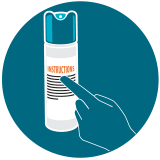
- Put screens on windows and doors. Fix screens that are loose or have holes.
- At sunrise and sundown (when mosquitoes that carry EEE are most active), consider rescheduling outdoor activities that occur during evening or early morning. If you must be outside, wear long-sleeved shirts and long pants and use bug spray.
- Use EPA-approved bug spray with one of the following active ingredients: DEET (20-30% strength); picaridin, IR3535; and oil of lemon eucalyptus or paramenthane. Always read the label and follow all directions and precautions.
- Do not use bug spray with DEET on infants under two months of age. Children should be careful not to rub their eyes after bug spray has been applied on their skin. Wash children's hands with soap and water to remove any bug spray when they return indoors.
- Put mosquito netting over playpens and baby carriages.

- Get rid of anything around your house and yard that collects water. Just one cup of water can produce hundreds of mosquitoes; an unused tire containing water can produce thousands of mosquitoes.
- Clean your gutters and downspouts so that they can drain properly.
- Remove any water from unused swimming pools, wading pools, boats, planters, trash and recycling bins, tires, and anything else that collects water, and cover them.
- Remove or treat any shallow water that can accumulate on top of a pool cover. Larvicide treatments, such as Mosquito Dunks can be applied to kill immature mosquitoes. This environmentally-friendly product is available at many hardware and garden stores and online.
- Change the water in birdbaths at least two times a week and rinse out birdbaths once a week.
- Horses are particularly susceptible to WNV and EEE. Horse owners are advised to vaccinate their animals early in the season and practice the following tips
- Remove or cover areas where standing water can collect.
- Avoid putting animals outside at dawn, dusk, or during the night when mosquitoes are most active.
- Insect-proof facilities where possible and use approved repellents frequently.
- Monitor animals for symptoms of fever and/or neurological signs (such as stumbling, moodiness, loss of appetite) and report all suspicious cases to a veterinarian immediately. If you are unsure if your horse is properly vaccinated, you should consult with your veterinarian.
- Do not consume any harvested deer that appears unhealthy. Any harvested animal that is believed to be unhealthy should be reported to DEM's Division of Law Enforcement at 222-3070.
- DEM recommends that hunters wear appropriate personal protective equipment when field dressing all game. At a minimum, this includes rubber or nitrile gloves and clothing that covers any part of the body that could be exposed to blood or other fluids.
- According to both CDC and USDA Wildlife Services there is negligible risk to hunters for contracting EEE from field dressing, handling venison, or consuming venison if proper personal protective equipment is worn while dressing, and the venison is properly cooked. There is a very small risk from exposure to the brain or spinal cord of a deer infected with EEE; therefore anyone who is decapitating or removing the antler cap from a deer during the time where the virus may be present (2 weeks after a killing frost) should wear eye protection and avoid any contact of brain or spinal cord tissue, or spinal fluid, with their eyes or any other mucous membrane.
Prevent Mosquito Bites
In 2019, aerial spraying occurred in four areas of Rhode Island that state officials assessed to be at critical risk for the Eastern Equine Encephalitis (EEE) virus.
A second aerial spraying application was held on September 25 to control adult mosquitos in two areas of Rhode Island assessed at a critical risk for the EEE virus. The areas were identified using several factors, including information about new human cases of EEE, cases of EEE in non-human mammals, positive mosquito samples in Rhode Island and in neighboring states, and information about the habitats in which mosquitoes most readily breed.
Parts of 12 communities were aerially treated with mosquito pesticide. The spray area surrounding West Warwick included all West Warwick and parts of Cranston, Warwick, East Greenwich, West Greenwich, Coventry, and Scituate. Some of this area was previously sprayed on September 9, but officials expanded this zone westward to Route 102 in Coventry and both westward and southward in West Greenwich. The southwest area included much of Westerly and parts of Hopkinton and Charlestown that were already sprayed on September 10. This expanded area of critical risk encompassed new swaths of Hopkinton, Richmond, and Charlestown as well as the southwestern section of South Kingstown.

In all, the state treated parts of 21 communities over three nights, from September 8 to 10, with a pesticide formulated to kill adult mosquitoes. The flight crew used the pesticide, called Anvil 10+10, at an extremely low concentration, dispersing a total of 556 gallons across 115,179 total acres – meaning that 6/10 of an ounce, aerosolized, was used to treat an acre. That's the equivalent of slightly less than four teaspoons per acre.
Sunday, Sept. 8: Zone 1 & 2 completed
area included all of West Warwick and parts of Coventry, Cranston, Warwick, East Greenwich, and West Greenwich; and all of Central Falls, Pawtucket, and North Providence and parts of Providence, East Providence, Smithfield, Lincoln, and Cumberland.
Monday, Sept. 9: Zone 3 completed
included parts of Burrillville, North Smithfield, and Woonsocket
Tuesday, Sept. 10: Zone 4 completed
included parts of Westerly, Hopkinton, and Charlestown
